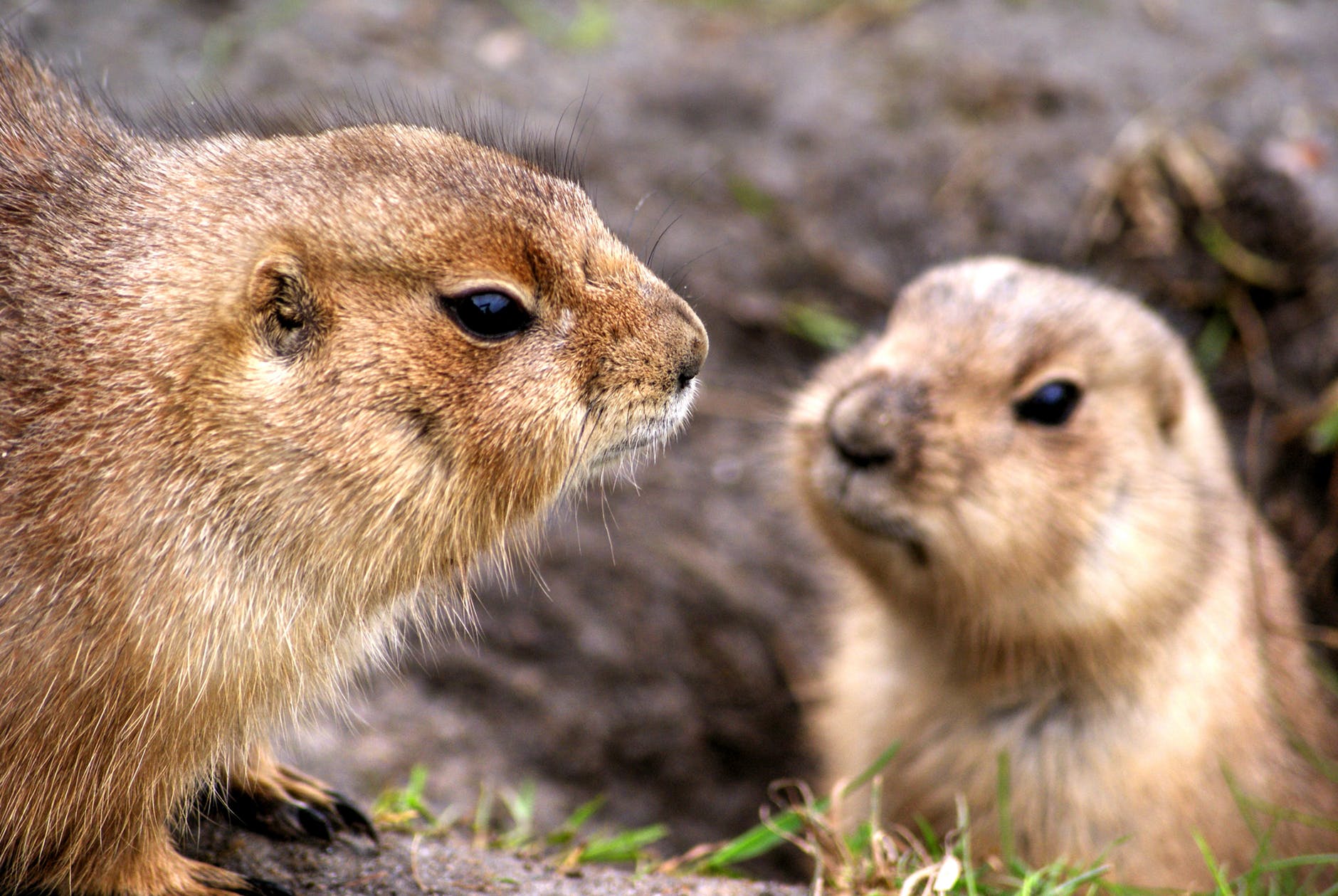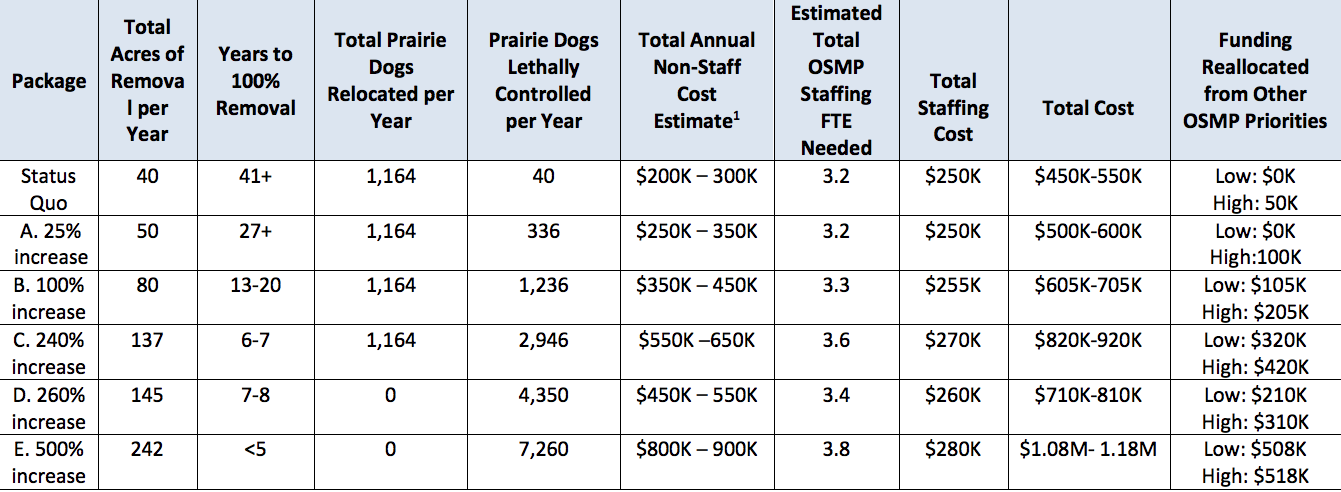Open Space trustees give stamp to $2.1M plan to clear Boulder ag lands of prairie dogs

Saturday, March 14, 2020 (Updated Sunday, March 15)
The stewards of Boulder’s vast open space lands have recommended that city council approve a slightly modified staff plan to kill 5,500 prairie dogs over the next three years on irrigated agricultural fields. The effort will clear 300 acres by 2022 at a cost of $2.1 million.
Trustees pushed for even swifter action, including increased lethal control of the rodents — a keystone species — and less focus on more expensive removal methods. Members of the public had similar concerns, criticizing staff for what they saw as a timid and unnecessarily costly approach that won’t address the problem quickly and efficiently.
Staff defended its recommendation as a good balance of community and open space values (protecting wildlife and promoting farmland) while slowly dipping a toe into controversial lethal control.
The preferred plan “represents a better starting point” than the other alternatives,” Open Space and Mountain Parks Senior Planner Mark Gershman said. “It didn’t suggest that we were going to go from a small amount of lethal control to a vast amount of lethal control, (which is) difficult operationally as well as representing a significant change for the community.”
“We don’t make recommendations that we don’t think we can do,” added OSMP Director Dan Burke. “The proposed plan is what we think we can do.”
Efforts will be concentrated in a 967-acre “project area” north of Jay Road. Lethal control would not begin until 2021, as staff secures legal authority — via a code change or city manager rule — prepares a competitive bidding process and hires contractors. Management in 2020 will continue with current practices: relocating roughly 1,200 prairie dogs per year from 40 acres.

Option C is staff’s preferred plan and the one advanced by OSBT on Wednesday.
Option C non-staff cost breakdown, 2020-2022
$475,000 relocation
$213,000 lethal control total, including:
- $183,000 to trap and donate prairie dogs to raptor/ferret programs and
- $30,000 for PERC*
$343,000 barriers
$81,000 restoration
$183,000 mitigation fee (to be paid into fund that promotes preservation and conservation of prairie dogs)
*PERC = Pressurized exhaust rodent control, or the application of lethal gasses into burrows. Prairie dogs are then left in the burrows to decompose.
Source: OSBT meeting packet and staff presentation
Boulder is budgeting significantly more than the county spends. Resource Manager Therese Glowacki in May 2019 told city council that Boulder County clears 530 acres each year for $150,000-$200,000.
There are many reasons for the huge disparity, Agricultural Resources Supervisor Rob Alexander said. For one, the county has been practicing lethal control since the early 2000s and so has in-house expertise and equipment. Boulder doesn’t: it will rely on contractors to do the work, at least for the foreseeable future.
Consultants are more expensive, department spokesperson Phillip Yates noted in response to emailed questions, but “staff is wary of investing in expensive equipment that may only be required for a relatively few number of years.”
Each piece of land is unique as well, Alexander said. It’s not fair to compare Boulder’s per-acre costs to the county’s — as many of Wednesday’s public speakers were doing — nor even to compare per-acre costs across broad swatch of land. Topography, density of prairie dogs, soil texture and many other factors influence removal.
“Costs are extremely variable per acre; you really have to look at it property by property,” he said. “There’s a big focus on the numbers of acres and the cost per acre. I’m trying to steer ppl away from that.”
Per-acre costs
Based on projected costs of $2.1M for 2020-2022 and 300 acres of removal
Option C total: $7,000 (Not including staff time: $4,333)*
Relocation: $4,400 per acre (done to the city wildlife ordinanceA piece of municipal (city-level) legislation. standard)
Trap and donate: $4,000 per acre (25% of animals captured within a week)
PERC: $221 per acre (75% of animals left over after trapping)
Restoration costs: $124 to $360 per acre
*This estimate was calculated using cost projections specific to Option C; the rest of the estimates were provided by staff in the OSBT meeting notes.
Finally, because Boulder is switching from a no-kill land management policy, the starting line is different. It took the county many years to rein in prairie dog populations, Alexander said — a change that only came when it limited trapping and focused more gassing burrows.
When lethal control was first OK’d, “we did not want to abuse that (and) lose public trust. We set a number of prairie dogs we wanted to trap before we implemented lethal control. We made that threshold very high, and it kept us in a cycle of going back (to the same piece of land). We had many years of trapping and we were not making progress.”
Now, Alexander said, the goal is “when we do removal, we don’t want to come back and do it again.”
Open Space trustees seemed to be thinking along the same lines Wednesday. Success of the plan is “critically dependent” on getting ahead of population growth, trustee Curt Brown said.
“This problem is a lot bigger than we think it is, and it’s growing a lot faster than we think it is,” Brown said. “We should throw everything at this that we can find.”
The board talked at length about ways to bring down costs and expedite removal. It nixed a proposal to have the city pay $1,000 per acre cleared into a fund for the preservation of prairie dogs, a nod to the concerns of the Prairie Dog Working Group. Trustees also suggested that the recommendation to council should limit relocation or trapping prairie dogs to be donated to raptor and ferret recovery programs.
“It seems like a waste to kill them and not feed other animals,” chair Tom Isaacson said. “But, boy, it comes at a pretty high price.”
Trustees also questioned at length when a property would be considered “cleared.” Consensus wasn’t reached on what percentage of prairie dog occupation should be set as a target; it’s better, Hal Hallstein said, to listen to the farmers.
“The real goal is to have our agricultural community come back to us and say, ‘Thank you, my operation is viable,'” Hallstein said. “The farmer will know better than anyone” what success looks like. “It’s not about chasing things to zero.”
But, he added, we can’t stay below population growth rates, “because then it’s just kabuki theatre.”
View a Twitter thread of Wednesday’s discussion here.
There was much disagreement over staff’s projected 3% growth rate. Several members of the public contended that prairie dog populations have doubled on their land in recent years.
Those rates are important for projections, because they determine how long it will take to clear affected acreage. At 3% growth, for instance, it will take 6-7 years under Option C to remove prairie dogs from 536 acres. (It would take 41 years with current relocation practices.)
How confident is staff that the growth rate is 3%, trustee Brown asked.
“I feel absolutely confident that last year it was 3%” in the project area, said Victoria Poulton, prairie dog conservation and management coordinator. (OSMP spokesperson Yates wrote that it has been 3% the past two years.)
The higher growth rates community members noted were common in years past, Poulton said. “After plague, it tends to be a very rapid increase and then levels off. We’ve seen the last three years it leveling off.”
To farmers and ranchers, who have lost hundreds of once-productive acres to proliferating prairie dogs, the spread has been devastating. Staff said that 280 acres in the project area are no longer being leased. Thousands of other acres are occupied but still being rented. Two properties have more than 50% occupation, costing tenants valuable acreage and revenue.
Marcus McCauley, of McCauley Family Farm in Longmont, said farmers favor lethal control not “because we’re evil farmers (but) because we know what it’s like to have our year’s work disappear before our eyes.”
There still remains a sizable and vocal minority who oppose lethal control, something staff said factored into its selection of Option C.
“(It) felt like a more consistent pathway from existing city practices (and) allowed us to address what we heard as a significant number of community members who felt that including relocation as a strategy was an important part of our approach as a community,” Gershman said.
A public hearingScheduled time allocated for the public to testify or share commentary/input on a particular ordinan... before city council is scheduled for April 21, though council’s workplan is subject to change amid the coronavirus outbreak.
Author’s note: This story has been updated to clarify that OSBT recommended an amended version of the staff-preferred Option C.
— Shay Castle, boulderbeatnews@gmail.com, @shayshinecastle
Want more stories like this, delivered straight to your inbox? Click here to sign up for a weekly newsletter from Boulder Beat.
Open Space Prairie dogs agriculture Boulder Boulder County city council city of Boulder drought farmers farmland irrigated agriculture Jay Road keystone species lethal control management open space Open Space Board of Trustees Open Space Mountain Parks Prairie Dog Working Group prairie dogs public hearing ranchers relocation soil health survey


gassing prairie dogs and leaving them in the burrows? They can and do carry cholera at times. Can agricultural produce be contaminated with cholera?
Hi, KC. I think you’re new here, but commenters must use their full first and last name when posting. Thanks!